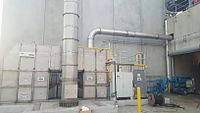
Photo from wikipedia
Abstract Heat exchanger networks (HEN) in industrial heat recovery systems often consist of large and complex subsystems. Usually, such HENs are subject to variation in operating conditions, such as varying… Click to show full abstract
Abstract Heat exchanger networks (HEN) in industrial heat recovery systems often consist of large and complex subsystems. Usually, such HENs are subject to variation in operating conditions, such as varying inlet conditions or changing heat capacity flow rates. Additionally, complexities such as stream splits and recycle loops are commonly present in industrial HENs. Therefore, extensive modelling and/or analytical calculations may be necessary when analyzing different retrofit proposals. Furthermore, retrofit opportunities in industrial heat recovery systems are often constrained by operability considerations, i.e. retrofit actions are supposed to have as little impact as possible on the production process to maintain the quality of the core product. In this work, a computational analysis tool is proposed for effective screening of HEN retrofit design proposals at an early stage in the design process. The proposed tool enables fast evaluation of the network’s response, i.e. temperatures and heat loads, when operating conditions change and/or operational settings are manipulated, and it is applicable for a wide range of HEN structures. The practical use of the analysis tool is demonstrated in a case study on the HENs of a large modern Kraft pulp mill.
Journal Title: Applied Thermal Engineering
Year Published: 2021
Link to full text (if available)
Share on Social Media: Sign Up to like & get
recommendations!